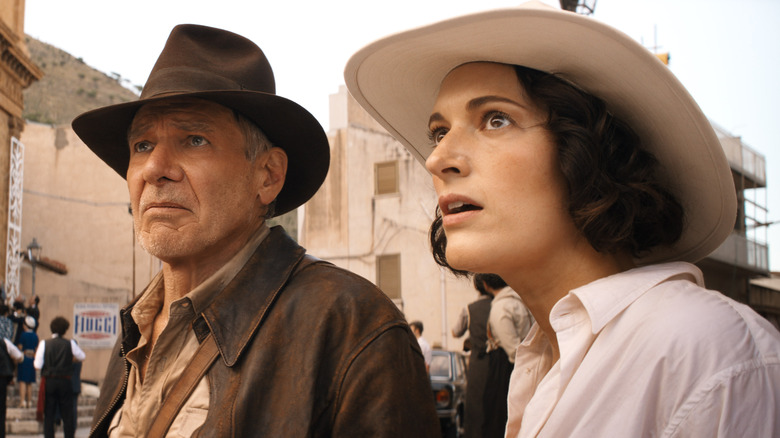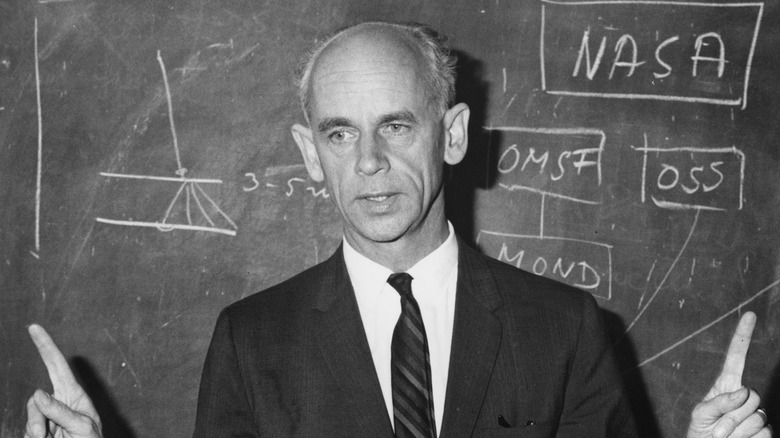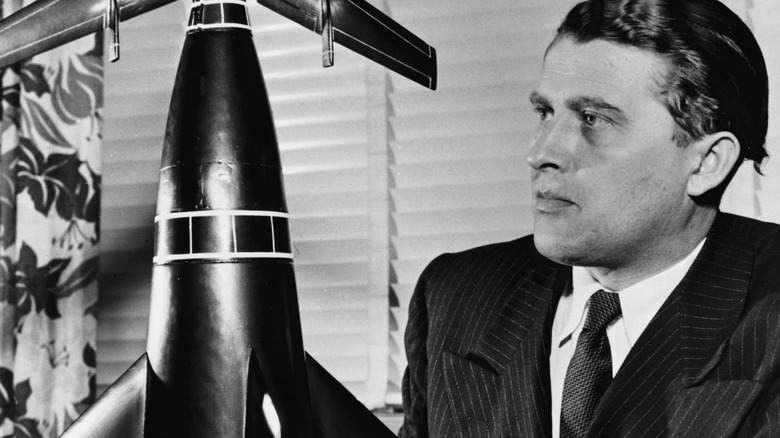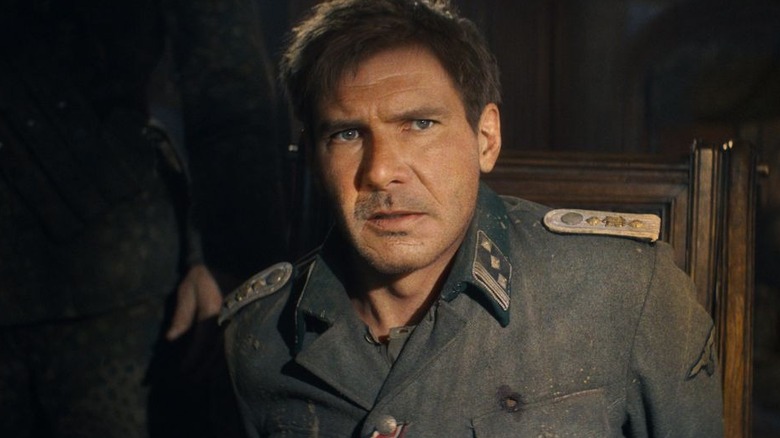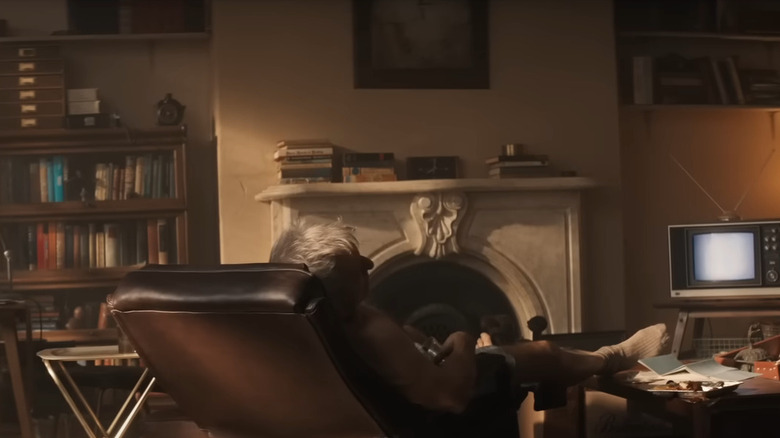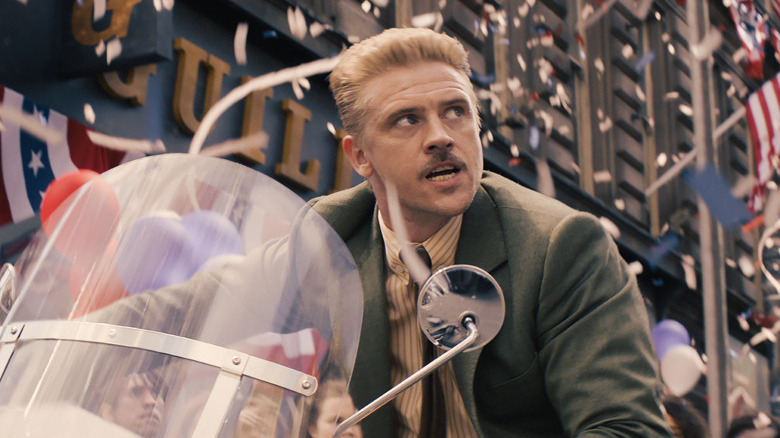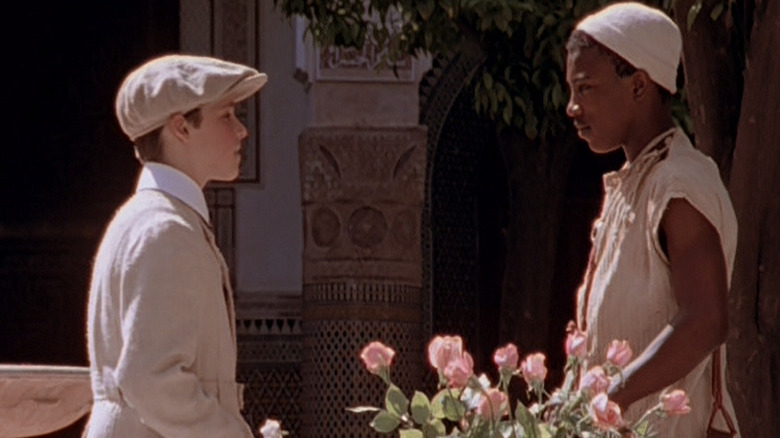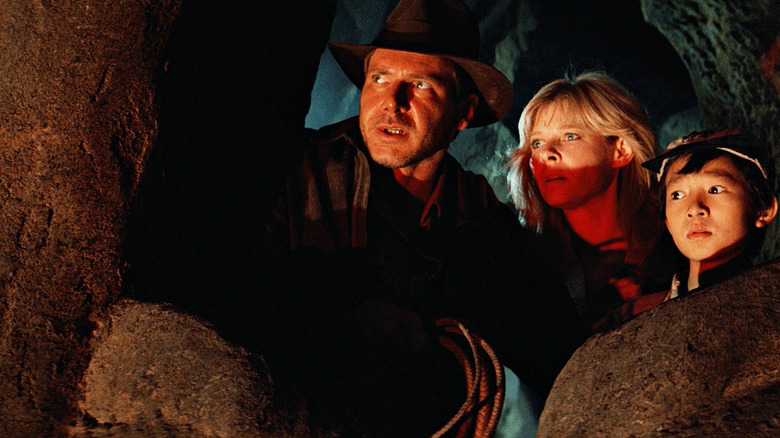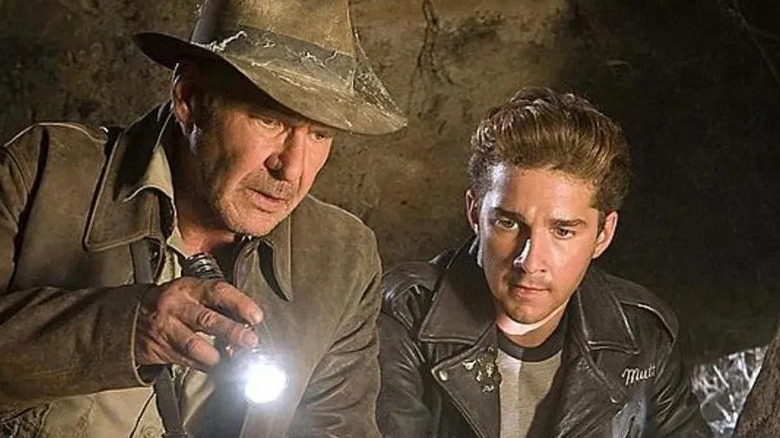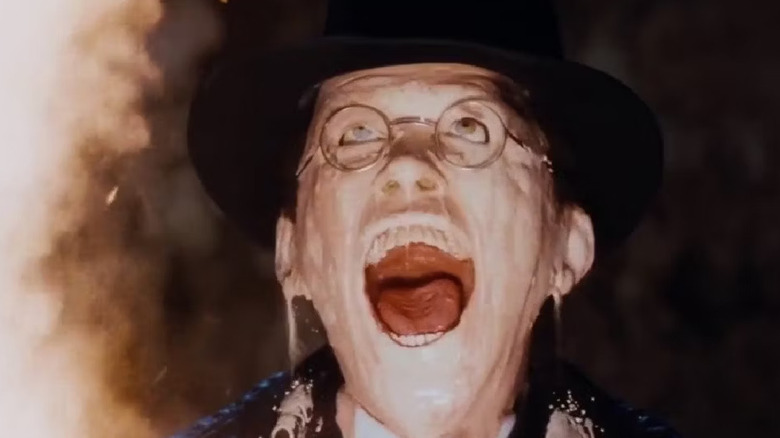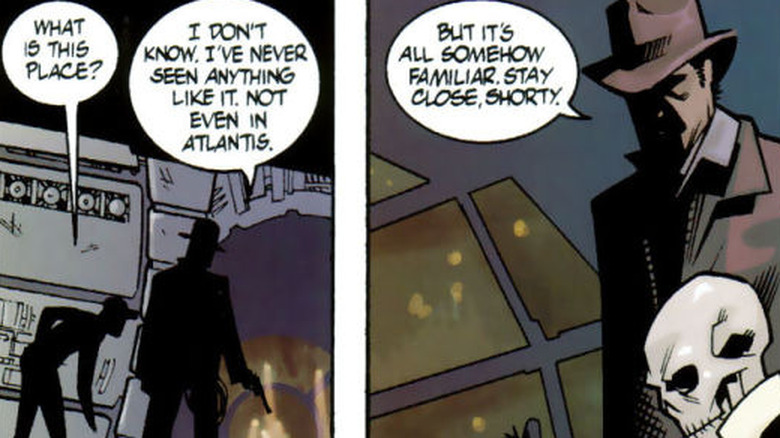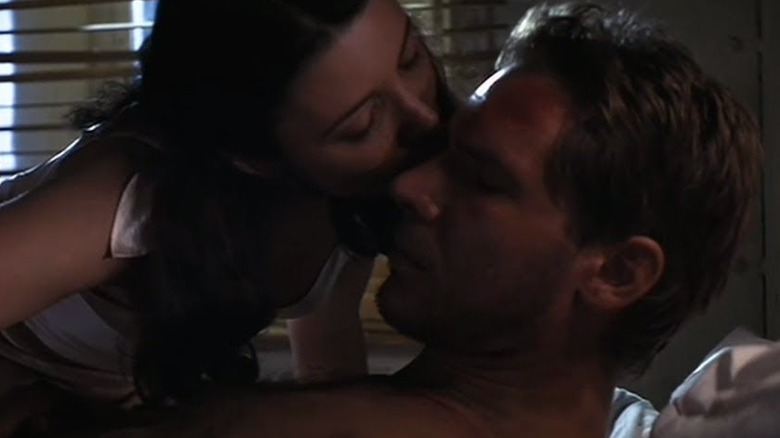Small Details You Missed In Indiana Jones And The Dial Of Destiny
Indiana Jones is a rugged, globe-trotting, Nazi-killing archaeologist played by Harrison Ford — and a bona fide cinematic icon. The original trilogy of films — 1981's "Raiders of the Lost Arc," 1984's "Indiana Jones and The Temple of Doom," and 1989's "Indiana Jones and the Last Crusade" — were born out of a love of B-movie adventure films from the '30s long held by Steven Spielberg and George Lucas.
In 2008, the gang re-grouped for "Indiana Jones and the Kingdom of the Crystal Skull"; despite some fun action set-pieces, "KotCS" was largely dismissed for shoddy CGI, its final reveal of Indy discovering a pulp-style UFO, and of course, the infamous nuking of the fridge.
The great adventurer is back with "Indiana Jones and the Dial of Destiny," directed by James Mangold. This film is set in 1969, with Jones (Ford) retiring as a professor. Helena Shaw (Phoebe Waller-Bridge) — his god-daughter and the adult child of his old colleague Basil (Toby Jones) — gets him involved with one last caper. This one involves Indy and Helena attempting to stop Jürgen Voller (Mads Mikkelson) — a Nazi Indy once fought in the past — from finding the Antikythera, an artifact that could change the course of time.
The film spans multiple decades and has many fun details to mull over — such as reused props, references to past films, and character's fates. Below, a (spoiler-heavy) breakdown of all that and so much more.
Operation Paperclip was a real thing
"Dial of Destiny" is set in 1969, and part of its backstory involves the Apollo 11 moon landing. It is stated that the main villain of the film, Jürgen Voller (Mads Mikkelsen) — who goes by the much less conspicuous name "Dr. Schmidt" — is a former Nazi scientist scooped up by the United States government at the end of World War II to help build rockets for NASA.
This is based on a real US government program called "Operation Paperclip" (via history.com), also mentioned briefly in "Captain America: The Winter Soldier." Essentially, during WWII, German scientists developed V-2 rockets, some of the most advanced at the time. Afterwards, once the Nazis surrendered, their tech, scientists, and research were all up for grabs.
Although "Paperclip" was originally launched to stop German scientists from taking their research to other potential enemies, the US soon began a decades-long Cold War with former ally The Soviet Union; "Paperclip" served as a scientific advantage for the US, helping significantly with getting a jump on the so-called "Space Race." Over 1600 scientists, as well as engineers and technicians, came over from former Nazi Germany, many given lucrative jobs. Many of these scientists worked for NASA, many on multiple Apollo missions — including Apollo 11, as seen in the film. Although some played central roles in developing things like space suits, the Hubble telescope (including Ernst Stuhlinger, pictured above) and the Saturn V launch vehicle — which made human missions to the moon possible — multiple Paperclip scientists would later be investigated and/or disgraced over their ties to the Nazi Party.
The Voller character is loosely based on Wernher von Braun
As Nazi scientists were given sanctuary by the United States government, their particular knowledge of rocket science being seen as an asset, one of the most prominent was Wernher von Braun — who worked on the Apollo 8 mission and helped develop the Saturn V rocket that landed American astronauts on the moon. It was eventually discovered that von Braun had worked as a rocket scientist for Nazi Germany during World War II, thereby aiding the fascist regime in developing the V-2 rocket. While he had denied direct culpability to Nazi cruelty, documents were later discovered that showed evidence of von Braun being aware of slave labor, killing test subjects, and overall dangerous working conditions during his experiments (via PBS).
Mads Mikkelsen's villainous Jürgen Voller in "Dial of Destiny" is based on von Braun (via Empire). This includes feigned ignorance of Nazi war crimes carried out in Hitler's name, as well as pretending to be "apolitical" in geo-political affairs — which turned out to be false for both von Braun and the fictional Voller. Another thing they have in common is working on the Apollo 11 mission that took American astronauts to the moon.
Indy fighting in WWII mentioned in Crystal Skull
While the original '80s trilogy of Indiana Jones films were always World War II adjacent — with Indy often traveling across the world to stop Nazis from obtaining ancient supernatural artifacts — Indiana Jones has never been shown fighting in the actual war itself. Even the last film in the original trilogy — "Crusade" — was set in 1938, a year before Hitler declared war (via National WW2 Museum).
"Dial of Destiny" changes that with an eye-popping fifteen-minute action scene starring a CGI/deepfake young Indy as he infiltrates (and escapes) a Nazi fortress, later saving his friend on a Nazi train. This is also where he steals back half of the Antikythera from a younger version of Mads Mikkelsen's villain Jürgen Voller. It's an impressive — if possibly overlong — sequence.
The fact that Indy enlisted and fought covertly in World War II shouldn't surprise anyone. Despite his well-documented hatred of the enemy ("Nazis... I hate these guys!") in the previous films, Indy's military service isn't directly referenced until "Crystal Skull." In that film, after the Area 51 and "nuking the fridge" sequences, Indy is interrogated by stuffy G-men stooges. They mention and congratulate Indy's exemplary military service, before admonishing him and interrogating him with the suspicion he could be a spy.
The painting of the Leap of Faith from Last Crusade is hanging on Indy's wall
In "Dial of Destiny," after the exciting World War II prologue, the film cuts to a much older Indiana Jones — now 70, nearly a decade younger than the actor playing him — living in a small, messy apartment. Indy is now much older and crankier, and viewers are introduced to him getting annoyed by young neighbors partying. He even carries a baseball bat to threaten them.
There are, of course, mementos and references to his past adventures strewn throughout his apartment. One that stands out is a painting of the magical "Leap of Faith" bridge, as seen in the climax of "Last Crusade." In that film, Indy had to cross the bridge — relying on his Biblical knowledge to get to the other side. It was the last test Indy had to overcome to get to the coveted "Holy Grail" before the Nazi villains.
It makes sense that Indy would keep this particular memento, as this happened during an adventure with his father, played in that film by Sean Connery. The test was also a monumental accomplishment for Indy, as he succeeded in that task due to his wits and historical knowledge, rather than fisticuffs and good fortune. Of course, it's also just a fun Easter egg for a production designer to sneak in there for the fans.
Boyd Holbrook played the villain in Mangold's Logan
Prior to jumping into the "Indiana Jones" realm, Mangold established a long, varied filmmaking career. In addition to 2001's "Kate & Leopold," 2010's "Knight and Day," and 2019's "Ford v Ferrari," he made 2017's "Logan," the post-apocalyptic, R-rated "X-Men" spin-off designed to be a swan song for Hugh Jackman's Wolverine. The film was well-received, but Jackman is now working to return to the character for the upcoming "Deadpool 3."
Regardless, one of the more memorable villains in "Logan" was Pierce (played by Boyd Holbrook), a smarmy but violently dangerous mercenary with a cybernetic arm, looking for the young female mutant X-23 (Dafne Keen). In "Destiny," Holbrook plays the character of Klaber, Voller's right-hand man.
Despite his classic looks and charisma — and lead, heroic roles in 2018's "The Predator" and the Netflix series "Narcos" — Holbrook seems to thrive in villainous roles, including a recent turn as The Corinthian in "The Sandman." This is true for his "Dial of Destiny" character Klaber, whose crew cut hairdo and nice suit makes him camouflage (presciently) as just another American conservative authority figure. He is ruthless and scary in the role and certainly makes an impact on screen. It makes sense that Mangold would bring him back for more villainous work in a big franchise film.
YouTuber Anthony Ingruber, famous for impressions of Harrison Ford, is in the film
Celebrity impersonators have long been a staple of comedy. The potential audience for impersonators seems to be larger than ever in the age of the internet and social media, and Harrison Ford has become an oft-caricatured celebrity due to his unique cadence and universally-recognized, charmingly curmudgeonly demeanor. This includes Mark Hamill — who acted alongside Ford in the "Star Wars" films — and has been known to do a great impression of his co-star on talk shows.
One of the better Ford impersonators, however, is actor/YouTuber Anthony Ingruber, who even played a younger Ford in 2015's "The Age of Adeline." In fact, he was so good, many people wanted him in the role of Han Solo for 2018's "Solo," which ultimately went to Alden Ehrenreich; according to "Solo" co-writer Jonathan Kasdan (whose father, Lawrence Kasdan, co-wrote "Raiders of the Ark"), Ingruber did indeed audition for the film (via Twitter).
Now, according to IMDb, in "Dial of Destiny" Ingruber is playing double for young Indiana Jones in the 1944 flashback at the beginning of the film. He can also be seen briefly in a blink-and-you'll-miss-it cameo as one of the shady gangsters in Tangier who surrounds Indy and Helena during her illegal auction.
Indy went to Tangier in an episode of Young Indiana Jones Chronicles
Between the release of the original Indiana Jones trilogy and the long-belated "Crystal Skull," there was a TV show adaptation entitled "The Young Indiana Jones Chronicles." The series ran for two seasons from 1992 to 1993 on ABC, spanning multiple decades in its storylines.
"Chronicles" had Corey Carrier playing Indy as a young boy, and Sean Patrick Flanery ("The Boondock Saints") playing the adventurer as a young man, with a framing device that cast actor George Hall in the role of an older Indy in the present day. River Phoenix had starred as a young Indiana Jones during the opening of "Last Crusade," but his tragic death ensured a recasting.
Re-edited "Chronicles" episodes and some newly-shot footage resulted in "My First Adventure," which tells the story of a young Indiana Jones (Carrier) finding himself adventuring in the Moroccan city of Tangier. In "Dial of Destiny," after Helena and her Short Round-esque kid sidekick Teddy (Ethann Bergua-Isidore) complain about an older Indy driving during a car chase in Tangier, he replies curtly, "I've been to Tangier before!," likely a reference to that "Young Indiana Jones Chronicles" TV movie.
Mentioning voodoo from Temple of Doom
Although "Temple of Doom" is the second film, it is a prequel to "Raiders of the Lost Ark." It follows Dr. Jones as he searches for a sacred stone, and in the process, finds himself saving kids who were stolen from a poor village and turned into slaves by an evil, ancient cult.
The film's gory violence had a hand in creating the PG-13 rating. Some have also criticized it for harmful stereotypes and misleading representations about the practice of Hinduism. Despite that, the film is also remembered for some amazing action set-pieces (such as the iconic mine cart chase), its epic and grandiose production design, and introducing the world to Ke Huy Quan, who would go on to win an Oscar for "Everything Everywhere All at Once."
In "Dial of Destiny," Indy mentions such adventures to Helena while climbing a cliff wall toward Archimedes' tomb. She asks Indy why he stops climbing at one point, and he explains it's because of all of his various injuries — including what happened to him dealing with supernatural voodoo in India — that has led to his body having some significant mileage on it.
The fate of Mutt Williams, son of Indy
One of the biggest contributions that the misbegotten "Kingdom of the Crystal Skull" film brought to the broader Indiana Jones lore was the introduction of Indy's long-lost son, Mutt Williams (played by Shia LaBeouf). In fact, the ending of that film greatly implies that LaBeouf's Mutt will take over as lead of the franchise going forward. The last scene of "KotCS" even has Mutt picking up Indy's iconic brown fedora, ready to put it on, before Indy takes it back at the last minute.
Unfortunately, LaBeouf's troubling personal issues — among other things — led to his ousting from the franchise (via Variety). This, of course, left a Mutt-sized hole in the plot of any sequel, which the film would have to find a way to fill in somehow (or, pull a Short Round and just ignore him completely). However, Mangold decided to give Mutt a surprisingly emotional narrative send-off.
At one point, Helena asks what Indy would change if he could go back in time, and he says he'd stop his son Mutt from enlisting and getting killed. While it's never stated explicitly that Mutt died serving in the Vietnam War, it's obviously what Indy is referring to. Not only does that fit the time period of the late-'60's, but there's also an early chase scene that happens during a Vietnam War protest on the street.
Nazis once again would've failed even without Indy's help
The Nazis are once again the villains for Indiana Jones in "Dial of Destiny"; this time around, Voller's plan is to kill Hitler and take over leadership duties, using his knowledge of the future and his supposedly superior intellect to win WWII.
However, the way time travel works in the film involves the Antikythera simply using calculations to find fissures in time to travel through (the Antikythera doesn't actually create the fissure itself). This means the calculations were made thousands of years ago — and Voller didn't account for the Earth's continental drift. So instead of going to WWII, they find themselves in the Siege of Syracuse, where Voller and his men's plane are shot and blown up by the Greek and Roman army.
This is similar to the spirits from The Ark melting the Nazi villain's faces in "Raiders," or them drinking from the wrong cup in "Last Crusade." Even without Indy's help, Nazi hubris always seems to do them in.
Indy constantly meeting historical figures
Indiana Jones, by being a character living in the past who has adventures throughout the world, has sometimes crossed paths with famous (or infamous) historic figures. This includes meeting Hitler during his rise to power in "The Last Crusade," losing his virginity to Mata Hari in an episode of "The Young Indiana Jones Chronicles," meeting Teddy Roosevelt, Pancho Villa, and Lawrence of Arabia in that same show, and even meeting Han Solo at one point in a comic book (though Han is long dead at that point, so Indy just sees Han's skeleton).
In "Dial of Destiny," Indy once again meets a great historical figure. In this case, Indy uses the Antikythera mechanism to find a fissure in time (or, rather, is taken hostage by Nazis who do that) to travel to ancient Greece during the Siege of Syracuse. Eventually, Indy meets the great mathematician and inventor Archimedes (played by Nasser Memarzia). Unlike his previous meetings with historical figures, Archimedes is not Indy's contemporary. In fact, the only way Indy is able to meet Archimedes is through time travel. They exchange some words as the battle between the Greeks and Romans rages in the background — and Indy even thinks about staying to witness history unfold — before Helena (literally) knocks some sense into him.
Marion and Indy's last lines references a scene in Raiders
At the end of "Crystal Skull," Indiana Jones and Marion Ravenwood (Karen Allen) tied the knot. However, at the beginning of "Dial of Destiny," it's made clear by a separation notice that he and Marion are in the process of a divorce. Whatever spark had re-ignited in the last film, it has once again dissipated. This is because, as explained in the film, after the death of Mutt Williams in Vietnam, their marriage began to dissolve as Marion succumbed to grief. Indy himself admits to Helena at one point that he wasn't equipped to console a spouse.
At the end of the film, Indy and Helena find themselves stranded in Ancient Greece — alongside the villainous Nazis, as well as Helena's sidekick Teddy, who stole a plane from some random guy. After the Nazis defeat themselves, Indy decides he wants to live and die in the past, witnessing ancient history firsthand, since he feels like he has nothing to live for in the present anymore.
Marion, however, is convinced to come back — presumably by Helena — and reconcile with Indy in 1969, giving him a reason to want to live again. Their final lines are reminiscent of a scene from "Raiders of the Lost Ark," as she searches for a place to kiss him that doesn't hurt. It's a fun, cute coda for the franchise.
